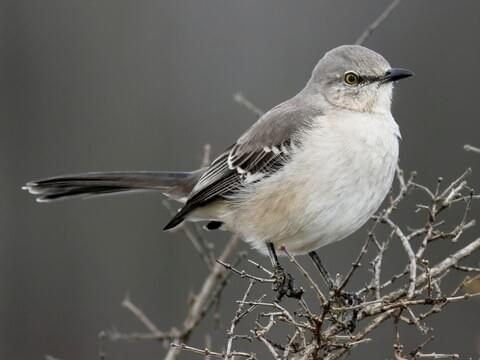Science Corner - The Incredibly Cool Northern Mockingbird

The Northern Mockingbird is a medium-sized songbird, roughly about the size of an American Robin. It’s kind of “blah” looking with its small head, long legs, and primarily grayish-brown body and lighter gray breast. Its wings are compact, roundish and broad, which appears to exaggerate the length of the tail when in flight. Each wing has two white wing bars which are visible when the wings are folded and a flashy white patch on the underside visible in flight. This white blob under each wing and a couple of white tail edges are seemingly perhaps the only ornate thing about this medium sized gray bird.
But wait, there’s more!
Their latin name, Mimus polyglottis, translates “many tongued mimic” and that it is! The male Northern Mockingbird has hundreds of songs in his repertoire and it’s now believed that he learned most of them before he even became an adult. This little disc jockey borrows material from other species of birds that they hear in their environment. They mix these borrowed tunes with their own and throw in some electronic sounds like car alarms, sirens, machinery. They pick up the sounds of musical instruments, dogs barking and even the sounds of frogs and toads. How’s that for fusion? Sometimes they mimic so well that if it weren’t for their tell-tale phrasing it might be hard to determine if it’s indeed the species being mocked or if it’s a Northern Mockingbird (NoMo) singing a cappella style. The male especially possesses some impressive improvisation skills and sometimes only uses certain songs once a season. His enthusiasm for serenading females is thought to convey that he will be a good provider for her and their offspring.
And, sometimes they just can’t stop singing. Interestingly, they’re one of the only song birds that sings at night. And they’re LOUD. And, they sing ALL NIGHT. Right outside your window. All night. Loud and proud. In all honesty, I think it is so cool to hear them singing in the dark, I don’t think I would ever get tired of it! Usually, the vocal marathons are either young males that haven’t found their duet partner yet or they’re older males that have lost their mate. They sing to attract a mate and to defend their territory although sometimes it seems that they sing just to hear themselves. And because the NoMo depends on their personal compositions rather than fancy, colorful feathers to attract a mate, it is believed that the more impressive the repertoire, the better equipped the male is to defend its territory, find food and raise young. The males are especially territorial and will dive bomb anything, even snakes or people that dare get too close to their nest. Beak to beak encounters usually result in a staring contest and some posturing and flashing of white patches until the other bird flies off. They will even defend their favorite food sources with vigor.
Northern Mockingbirds have adapted to life with humans extremely well. They like to be heard but they also like to be seen, perching conspicuously on fence posts or out in the open. They are common in suburban areas as well as open wildlands and forest edges. They are common in parks and backyards although they don’t visit bird feeders as often as other species of song birds do. They are omnivores and prefer insects during the summer months and fruit and nuts in the winter. They range throughout Mexico, the United States and southern Canada and although some migrate, most individuals do not.
Northern Mockingbirds are monogamous and mate for life. The male will begin building several stick nests and the female makes the final choice and finishes the chosen nest lining it with roots, grasses, animal hair and other soft material. Sadly, some nests also contain trash like cigarette filters and plastic. They are prolific breeders and a single pair may have six or seven clutches in just one season. One female laid an astonishing 27 eggs during a single nesting season.
Lady Northern Mockingbirds aren’t the only one who finds the male’s singing enchanting though. In the early 19th century, prior to the protections of the Migratory Bird Treaty Act, the East Coast population was nearly decimated due to the illegal pet trade. A particularly vocal bird could fetch $50 in the late 1920’s, that’s about $1,300 in today’s dollars. Thomas Jefferson was particularly fond of them as well and had one named Dick that was also a resident of the White House. The oldest known wild NoMo was nearly 15 years old but most live to about the age of six, captive birds can live up to 20 years.
It’s been said that these birds put all of their color into their songs and that they specialize in vocal excess. This feels like a spot on description of them.
-Kristie Ehrhardt (kehrhardt@tuleyome.org)
Tuleyome Land Conservation Program Manager
RECENT ARTICLES






